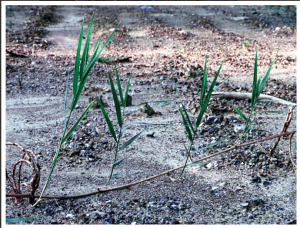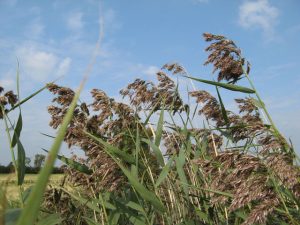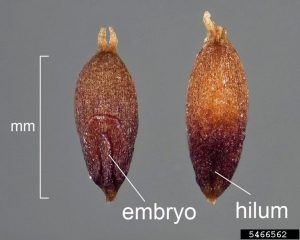Common Reed Phenophase Definitions
Directions: As you report on phenophase status (Y, N or ?) on the datasheets, refer to the definitions on this sheet to find out what you should look for, for each phenophase in each species. To report the intensity of the phenophase, choose the best answer to the question below the phenophase, if one is included.

Image source: Ohio State Weed Lab Archive, Ohio State University
Leaves
Initial growth: New growth of the plant is visible after a period of no growth (winter or drought), either as new green shoots sprouting from nodes on existing stems, or new green shoots breaking through the soil surface. For each shoot, growth is considered “initial” until the first leaf has unfolded.
How many needles or needle bundles are emerging?
Less than 3; 3 to 10; 11 to 100; 101 to 1,000; 1,001 to 10,000; More than 10,000
Leaves: One or more live, green, unfolded leaves are visible on the plant. A leaf is considered “unfolded” once it unrolls slightly from around the stem and begins to fall away at an angle from the stem. Do not include fully dried or dead leaves.
What percentage of the plant is green?
Less than 5%; 5-24%; 25-49%; 50-74%; 75-94%; 95% or more
Flowers
Flower heads: One or more fresh flower heads (inflorescences) are visible on the plant. Flower heads, which include many small flowers arranged in spikelets, emerge from inside the stem and gradually grow taller. Include flower heads with unopened or open flowers, but do not include heads whose flowers have all wilted or dried.

Image source: Jonathan Wilkins Guide
How many fresh flower heads are present?
Less than 3; 3 to 10; 11 to 100; 101 to 1,000; More than 1,000
Open flowers: One or more open, fresh flowers are visible on the plant. A flower is considered “open” when reproductive parts (male anthers or female stigmata) can be seen protruding from the spikelet. Do not include flowers with wilted or dried reproductive parts.
NOTE: Flower clusters are typically purplish when young, and white or light brown when mature.
What percentage of all fresh flowers (unopened plus open) on the plant are open?
Less than 5%; 5-24%; 25-49%; 50-74%; 75-94%; 95% or more
Pollen release: One or more flowers on the plant release visible pollen grains when gently shaken or blown into your palm or onto a dark surface.
How much pollen is released?
Little: Only a few grains are released; Some: Many grains are released; Lots: A layer of pollen covers your palm, or a cloud of pollen can be seen in the air when the wind blows.

Image source: D. Walters and C. Southwick, CPHST, Bugwood.org
Fruits
Fruits: One or more fruits are visible on the plant. For Phragmites australis, the fruit is a tiny grain, hidden within tiny bracts and grouped into small clusters that are closely arranged on a large, wide, open-branched plume (or seed head), that changes texture from soft or watery to hard and drops from the plant. Do not include seed heads that have already dropped all of their grains.
How many fruits are present?
Less than 3; 3 to 10; 11 to 100; 101 to 1,000; More than 1,000
Ripe fruits: One or more ripe fruits are visible on the plant. For Phragmites australis, a fruit is considered ripe when it is hard when squeezed and difficult to divide with a fingernail, or when it readily drops from the plant when touched. Do not include seed heads that have already dropped all of their grains.
What percentage of all fruits (unripe plus ripe) on the plant are ripe?
Less than 5%; 5-24%; 25-49%; 50-74%; 75-94%; 95% or more
Recent fruit or seed drop: One or more mature fruits or seeds have dropped or been removed from the plant since your last visit. Do not include obviously immature fruits that have dropped before ripening, such as in a heavy rain or wind, or empty fruits that had long ago dropped all of their seeds but remained on the plant.
How many mature fruits have dropped seeds or have completely dropped or been removed from the plant since your last visit?
Less than 3; 3 to 10; 11 to 100; 101 to 1,000; More than 1,000
